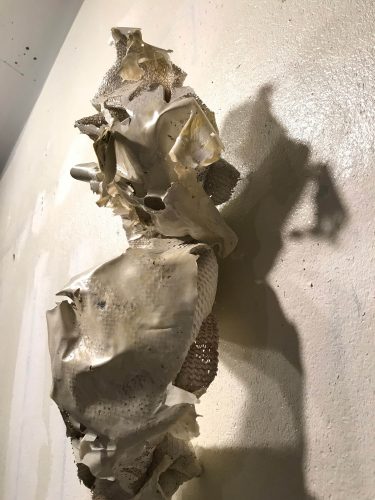
Chance meetings and random events in art were made popular a century ago by the Dadaists and Surrealists in Europe, and then by the Abstract Expressionists such as Jackson Pollock or Helen Frankenthaler in America.
I don’t mean to give you a history lesson, only to introduce “Dead Loss,” an exhibit currently showing at Slightly Coffee Roasters (previously Barn Light East) in Eugene through April 26.
The element of chance is, all these years later, so much a part of contemporary art that it is often taken as a given, almost a standard, and artists continue to look for ways to trick themselves into losing control.
One way to understand the pursuit of chance in art is to see it as giving up to some larger force. The Surrealists thought they were giving in to their own subconscious, to which they would otherwise have no access except possibly through dreams.
Pollock combined this goal with mystic or spiritual practices and imagery. He famously hunched over his large canvases and released control to gravity, allowing paint to drip without any pre-conceived design.
In an informative and revealing short video produced by Eugene Contemporary Art, Eugene artist Lillian Almeida talks about giving up control. “The work always comes back to the medium of paint,” she says. “The way paint moves and its uncontrollable freedom.”
Looking at her work you certainly do see the way paint splotches and drips and forms into irregular organic-looking shapes. However, there is planning as well. Sometimes the work is “super figurative,” and the random way paint is applied adds up to a grand design, such as when she paints portraits.
Other times the medium and randomness are all there is.
In her video Almeida explains how the medium, or materials, for this show were not chosen by her as much as she found them “springing forth.” In other words, the way she explains it, the materials were asking to be used. She feels that her artwork literally speaks to her and you can tell, watching the video, that she values this conversation. The artist is not in complete control because her materials have some say in the matter.
Not being entirely in control is tied in art to the much-valued experience of discovery — arriving at imagery through random events allows artists to feel they are discovering their creations as well as designing them. Discovery is sort of a magic word. I mean, who among us is against discovering some new thing in their work or perhaps, if lucky, in themselves?
I suggest you watch the video either before or after you see the show. It is not unlike the longer videos about artists available on PBS’s wonderful series Art21: Art in the 21st Century. Almeida imbues her choice of materials for this show with a sense of, I would say, deeper meaning. For example, she first saw the activity of peeling paint as a harmless pastime, a way of comforting herself, but then came to view it as a sort of discovery that was central to her work.
Someone not involved in the art world may be thinking right now that anyone who believes that paint can talk isn’t exactly connected to reality. But maybe paying attention and forming a connection in this manner is what it takes to be an artist now, the result of a lifetime of professional work chasing colors and shapes and looking for meaning in materials that others would discard.
Maddison Colvin, showing with Almeida, doesn’t work with paint. She uses a camera, an instrument of scientific precision, yet employing a scanner and working at night, she also has found a way to give up control. Colvin’s photographs are scans of her garden at night, and her images can be difficult to read.
Colvin’s interest in photographing nature stems from the idea that it is impossible to represent nature accurately without changing it in some way or even obliterating it. Representing and studying nature sometimes requires us to destroy the thing we seek to understand. For example, to understand human anatomy, artist and scientist Leonardo da Vinci went against a cultural taboo when he cut into the human body.
Colvin’s art is a reminder that even when trying to record seemingly passive and willing subjects, like plants, it’s possible we cut into them too, destroying our subject in our eagerness to represent.
“Dead Loss” is on display through April 26 at Slightly Coffee Roasters, 545 E. 8th Avenue.